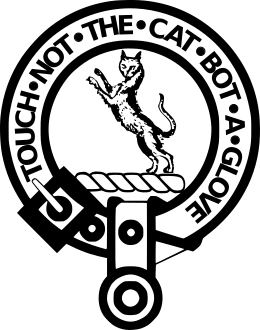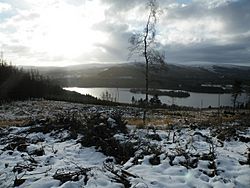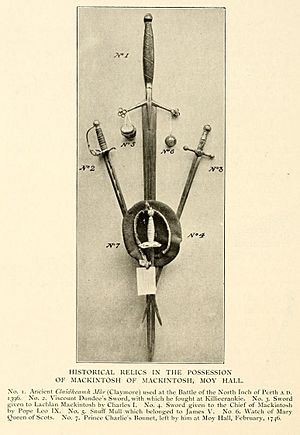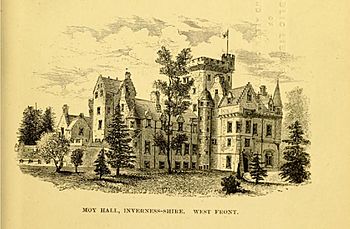Clan Mackintosh facts for kids
Quick facts for kids Clan Mackintosh |
|||
|---|---|---|---|
| Mac-an-tòisich | |||

Crest: A cat-a-mountain salient guardant Proper
|
|||
| Motto | Touch Not The Cat Bot A Glove (N.B. 'bot' means 'without') | ||
| War cry | Loch Moigh | ||
| Profile | |||
| Region | Highland | ||
| District | Inverness | ||
| Plant badge | Red whortleberry, bearberry, or boxwood | ||
| Chief | |||
| John Mackintosh of Mackintosh | |||
| The Mackintosh (An t-Ailpeanach) | |||
| Seat | Moy Hall | ||
| Historic seat | Moy Castle on Loch Moy | ||
|
|||
|
|||
|
|||
|
|||
Clan Mackintosh (also known as Clann Mhic an Tòisich) is a famous Scottish clan from Inverness in the Scottish Highlands. The main leaders of the clan are called the Mackintoshes of Mackintosh. Another part of the clan, the Mackintoshes of Torcastle, lead the Clan Chattan. This was a group of clans that worked together long ago.
Contents
History of the Clan Mackintosh
How the Clan Began
The Scottish Gaelic word toisiche means leader or chief. Stories from the Clan Mackintosh say that the first chief was Shaw. He was the second son of Duncan MacDuff, who was the Earl of Fife. In 1160, Shaw MacDuff went with Malcolm IV of Scotland to stop a rebellion in Morayshire. Around 1163, he became the constable (like a governor) of Inverness Castle. He was also given land in the Findhorn valley. The main area for the clan was the lands of Petty. This was also where the chiefs were buried. In 1179, Shaw MacDuff's son, also named Shaw, became the next chief. His right to the land was confirmed by William the Lion.
Battles and Wars
Fighting the Norwegians
In 1263, during the Scottish–Norwegian War, Ferquhar Mackintosh was the fifth chief. He led his clan in the Battle of Largs against the army of Haakon IV of Norway. Sadly, he was killed in a duel in 1265. This left his young son, Angus, as the new leader.
Joining Clan Chattan
Angus Mackintosh grew up with his uncle, Alexander Og MacDonald, Lord of Islay. In 1291, Angus married Eva. She was the only daughter of Dougal Dal, chief of the Clan Chattan. This marriage brought Angus lands in Glenloy and Loch Arkaig. Angus and Eva lived on Clan Chattan lands at Tor Castle. Later, they moved to Rothiemurchus. After this, the Clan Chattan became a special group of independent Scottish clans. The Mackintosh chiefs led this group. However, the Clan Macpherson often tried to challenge their leadership. From this time on, the histories of Clan Mackintosh and Clan Chattan are closely linked.
Supporting Robert the Bruce
During the Wars of Scottish Independence, the sixth chief of Clan Mackintosh supported Robert the Bruce. Bruce was a famous Scottish king.
Clan Conflicts in the 14th Century
Clan Mackintosh was involved in many clan battles. They had a long feud with Clan Cameron that lasted over 350 years.
- The Battle of Drumlui happened in 1337. It was a fight between Clan Mackintosh and Clan Cameron over land. The Camerons lost, and this started their long feud.
- The Battle of Invernahoven was fought in 1370. It was between Clan Cameron and the Chattan Confederation. The Confederation included Clan Mackintosh, Clan Macpherson, and Clan Davidson.
- The Battle of the North Inch in 1396 was a very important battle. It was fought between the Chattan Confederation, led by the Mackintoshes, and the Clan Cameron.
Clan Conflicts in the 15th Century
Ferquhar, the ninth chief, had to give up his leadership. His half-brother, Malcolm Beg Mackintosh, 10th of Mackintosh, became the new chief. Malcolm was a strong leader who made his clan more powerful. He had a feud with the Clan Comyn. In 1424, the Comyns took some Mackintosh lands. Malcolm fought back and many Comyns were killed. The Comyns then attacked the Mackintosh homeland of Moy. They tried to drown the Mackintoshes on their island. Later, a peace meeting was held at the Comyn's castle of Rait. But at this feast, the Mackintoshes attacked their Comyn hosts.
- The Mackintoshes fought at the Battle of Lochaber in 1429. This battle was between forces led by Alexander of Islay, Earl of Ross and the king's army.
- The Battle of Palm Sunday, 1429, was fought between the Clan Cameron and the Clan Mackintosh with the Chattan Confederation.
- The Battle of Craig Cailloch happened in 1441. The Clan Mackintosh, led by the chief's son, Duncan Mackintosh, 11th of Mackintosh, attacked Clan Cameron lands. In the battle, the chief's second son was wounded, and his fourth son was killed.
- The Battle of Clachnaharry was fought in 1454. It was between Clan Mackintosh and the Clan Munro.
The Raid on Ross
In 1491, Ferquhard Mackintosh, 12th of Mackintosh supported a rebellion led by Alexander MacDonald of Lochalsh. This event was called the Raid on Ross. Ferquhard also captured Inverness Castle using a "sow" (a type of siege engine). The king later put Ferquhard in Edinburgh Castle. He escaped two years later but was caught again and held in Dunbar Castle for sixteen years. He was released after the Battle of Flodden in 1513. While Ferquhard was in prison, his clan was managed by William Mackintosh.
16th Century Conflicts
In 1528, King James V ordered the "utter extermination" of Clan Mackintosh and its supporters. This was to punish the clan for problems in Badenoch. The king's representative captured 300 clan men. He began to hang them to find out where Hector Mackintosh, the chief's brother, was hiding. Hector eventually gave himself up and promised loyalty to the King.
Lachlan Mor Mackintosh, 16th of Mackintosh and his clan supported Mary, Queen of Scots. They helped her win against the Earl of Huntly at the Battle of Corrichie in 1562. It is also thought that Lachlan fought at the Battle of Langside in 1568 to defend the Queen.
The Battle of Bun Garbhain was fought in 1570 between Clan Cameron and Clan Mackintosh. The chief of Mackintosh is believed to have been killed in this battle by a Cameron warrior.
The Battle of Glenlivet was fought in 1594. Clan Mackintosh and the Chattan Confederation fought alongside the Earl of Argyll. They were defeated by the Earl of Huntly's forces, which included Clan Gordon and Clan Cameron.
17th Century and Civil War
During the Scottish Civil War, the Mackintoshes fought for James Graham, 1st Marquis of Montrose. He was fighting for Charles I of England.
The Stand-off at the Fords of Arkaig happened in 1665. It was between the Chattan Confederation, led by Clan Mackintosh, and the Clan Cameron.
The Battle of Mulroy was fought in 1668. Clan Cameron and Clan Mackintosh were at peace. But when the Cameron chief was away, a fight broke out between Clan MacDonald of Keppoch and Clan Mackintosh. The Camerons joined the MacDonalds. Together, they defeated the Mackintoshes, who had government soldiers helping them.
18th Century and Jacobite Risings
The 1715 Jacobite Rising
During the Jacobite rising of 1715, the Mackintoshes supported the Stuart royal family. Lachlan Mackintosh led 800 clan members to help the Jacobites. However, they were defeated at the Battle of Preston (1715). After this, many clan members were sent to the Americas. In 1724, a report estimated that the Mackintoshes and Farquharsons together could gather 800 men.
The 1745 Jacobite Rising
During the Jacobite rising of 1745, Angus Mackintosh was the twenty-second chief. He was a captain in the British Black Watch regiment. But his wife, Lady Anne Mackintosh, gathered men to fight for the Jacobite Charles Edward Stuart (Bonnie Prince Charlie). The command was given to MacGillivray of Dunmaglas. They helped the Jacobites win at the Battle of Falkirk Muir in 1746.
After this victory, Prince Charles arrived at Moy on February 16, 1746. Lady Mackintosh welcomed him. The prince's bed is still at Moy Hall today. Five hundred government soldiers tried to capture Prince Charles at Moy. But just five of Lady Mackintosh's helpers tricked them. They made the soldiers believe they had run into the entire Jacobite army. The soldiers fled, and this event became known as the Rout of Moy. At the Battle of Culloden, the Mackintoshes and their allies in the Chattan Confederation suffered heavy losses.
Clan Chiefs
John Lachlan Mackintosh of Mackintosh (born 1969) is the current chief. He became chief in 1995 and lives in Singapore. He is a history teacher at Nanyang Girls' High School.
Castles of Clan Mackintosh

Here are some castles that Clan Mackintosh has owned:
- Moy Hall is the current home of the Clan Mackintosh chief. The first Moy Hall was built around 1700. It replaced Moy Castle, which was on Moy Island in Loch Moy. The 1700 Moy Hall burned down by accident. A new Moy Hall was built around 1800. It was changed again in the 1870s with a tower and two large wings. It was found to have dry rot and was taken down in the 1950s. A simpler house was built in its place from 1955-1957.
- Moy Castle on Moy Island, in Loch Moy, was the first home of the Mackintosh chief in the 14th century. Only small parts of Moy Castle remain today.
- Borlum Castle was owned by the Mackintoshes. Later, a large house replaced the castle. It was the home of the Jacobite leader William Mackintosh of Borlum.
- Castle Stuart was once held by the Mackintoshes after they took it in a dispute.
- Culloden House, near Inverness, is a large house that includes parts of an old castle. The Mackintoshes once owned it but sold it to the Clan Forbes in 1626.
- Keppoch Castle was originally the home of the chiefs of the Clan MacDonald of Keppoch. The Mackintoshes fought over it and finally gained it in 1690.
- Rait Castle, near Nairn, was passed to the Mackintoshes from the Clan Comyn. Then it went from the Mackintoshes to the Clan Campbell of Cawdor. A story says a feast at the castle between the Comyns and Mackintoshes ended in a fight. The Duke of Cumberland is said to have stayed at the castle before the Battle of Culloden in 1746.
- Tor Castle, near Fort William, was held by the Mackintoshes. But the Clan Cameron took it in the 14th century.
See also




